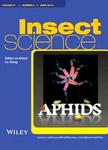Intercrop movement of convergent lady beetle, Hippodamia convergens (Coleoptera: Coccinellidae), between adjacent cotton and alfalfa
Intercrop movement of convergent lady beetle, Hippodamia convergens (Coleoptera: Coccinellidae), between adjacent cotton and alfalfa作者机构:Texas A&M UniversityAgriLife Research and Extension Center Lubbock Texas USA Department of Entomology Iowa State UniversityAmes Iowa USA Department of Entomology Nanjing Agricultural University Nanjing China
出 版 物:《Insect Science》 (昆虫科学(英文版))
年 卷 期:2016年第23卷第1期
页 面:145-156页
核心收录:
学科分类:0710[理学-生物学] 0830[工学-环境科学与工程(可授工学、理学、农学学位)] 090503[农学-草业科学] 0909[农学-草学] 07[理学] 0905[农学-畜牧学] 09[农学] 0904[农学-植物保护] 0901[农学-作物学] 071002[理学-动物学] 0713[理学-生态学]
基 金:USDA-CSREES International Cotton Research Center
主 题:enzyme-linked irnrnunosorbent assay Hippodamia convergens markcapture protein marker
摘 要:A 2-year study was conducted to characterize the intercrop movement of conver- gent lady beetle, Hippodamia convergens Guerin-Meneville (Coleoptera: Coccinellidae) between adjacent cotton and alfalfa. A dual protein-marking method was used to assess the intercrop movement of the lady beetles in each crop. In turns field collected lady beetles in each crop were assayed by protein specific ELISA to quantify the movement of beetles between the crops. Results indicated that a high percentage of convergent lady beetles caught in cotton (46% in 2008; 56% in 2009) and alfalfa (46% in 2008; 71% in 2009) contained a protein mark, thus indicating that convergent lady beetle movement was largely bidirectional between the adjacent crops. Although at a much lower proportion, lady beetles also showed unidirectional movement from cotton to alfalfa (5% in 2008 and 6% in 2009) and from alfalfa to cotton (9% in 2008 and 14% in 2009). The season-long bidirectional movement exhibited by the beetles was significantly higher in alfalfa than cotton during both years of the study. The total influx of lady beetles (bidirectional and unidirectional combined) was significantly higher in alfalfa compared with that in cotton for both years. While convergent lady beetles moved between adjacent cotton and alfalfa, they were more attracted to alfalfa when cotton was not flowering and/or when alfalfa of- fered more opportunities for prey. This study offers much needed information on intercrop movement of the convergent lady beetle that should facilitate integrated pest management decisions in cotton utilizing conservation biological control.



